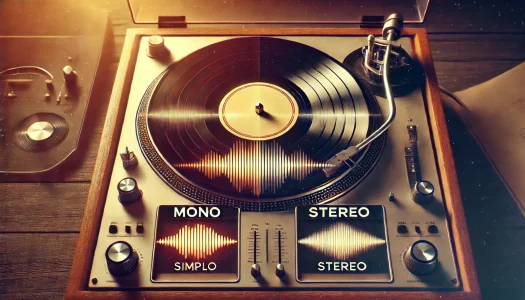When it comes to vinyl records, one of the key distinctions in audio formats is between mono and stereo recordings. A mono (monophonic) record uses a single audio channel, meaning the same sound is played through all speakers. In contrast, a stereo (stereophonic) record has two separate channels—left and right—allowing for a more immersive and spatial listening experience.
This difference matters because it affects how music is heard and experienced. Early recordings were designed for mono playback, while modern productions rely on stereo to create depth and dimension. For collectors, audiophiles, and casual listeners, understanding this distinction helps in choosing the right version of a record for their setup and personal preference.
What Is Mono Sound?
Mono, short for monophonic sound, uses a single audio channel to deliver the same sound to all speakers. Whether played through one speaker or multiple, the audio remains identical across the output, with no directional separation.
Before the 1960s, mono was the standard format for recorded music, as most playback systems—including radios, jukeboxes, and early record players—were designed for a single-channel signal. Iconic artists like The Beatles, Miles Davis, and Elvis Presley initially released their music in mono, with stereo versions often being an afterthought.
Mono recordings are ideal for older playback equipment and certain music styles, such as early rock & roll, jazz, and blues, where a centered, focused sound is preferred. Some collectors and audiophiles even argue that mono mixes offer a more authentic and balanced listening experience, as they were often the primary versions intended by artists and producers of the era.
What Is Stereo Sound?
Stereo, short for stereophonic sound, uses two distinct audio channels—one for the left speaker and one for the right. This separation allows for instruments, vocals, and effects to be positioned across a wider soundstage, creating a more immersive and realistic listening experience.
By the late 1960s, stereo became the industry standard as advancements in recording technology and home audio systems made multi-channel playback more accessible. Unlike mono, where all sounds are centered, stereo recordings give the illusion of depth and movement—guitars might be panned to one side, drums spread across both channels, and vocals placed in the center.
Today, nearly all music is produced in stereo, making it the default format for vinyl records, digital streaming, and physical media. However, some collectors and audiophiles still seek out original mono pressings for their historical accuracy and unique sonic characteristics.
How It Affects Listening Experience
The difference between mono and stereo isn’t just technical—it directly impacts how music is perceived.
Mono delivers a direct, focused sound where all elements of the recording are blended into a single channel. This can create a strong, punchy mix, especially for older recordings where stereo separation wasn’t originally considered. Vocals and instruments are evenly distributed, making it a great choice for listening on vintage equipment or in environments where stereo imaging isn’t necessary.
Stereo provides a more immersive experience, with instruments and vocals spread across a wider soundstage. A guitar might be heard from the left speaker while a piano plays from the right, giving the music a sense of depth and space. This format enhances live recordings, orchestral pieces, and modern studio productions where placement and movement within the mix are essential.
Collectibility & Vinyl Pressings
For vinyl collectors, the choice between mono and stereo can be about more than just sound—it’s often about authenticity and historical significance.
Original mono pressings are highly sought after by collectors, especially for albums recorded before stereo became the standard. Many artists and producers in the 1950s and early 1960s prioritized the mono mix, making it the definitive version in some cases.
Stereo versions of older recordings sometimes feature different mixes, alternate instrument placements, or even extra overdubs added after the fact. This makes some stereo pressings unique compared to their mono counterparts, particularly for albums from The Beatles, Bob Dylan, and The Rolling Stones.
Modern reissues often include both mono and stereo versions, allowing listeners to compare the differences. Some labels specialize in high-quality mono re-releases, catering to audiophiles who prefer the raw, punchy sound of the original mono mixes.
Whether for nostalgia, sound preference, or rarity, mono vs. stereo remains an important debate in the world of vinyl collecting.
